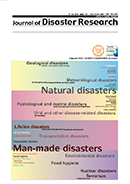16 巻, 6 号
選択された号の論文の13件中1~13を表示しています
- |<
- <
- 1
- >
- >|
Special Issue on the Great East Japan Earthquake Disaster: Part VI - Thoughts About the Great Disaster Now That Ten Years Have Passed -
-
原稿種別: Editorial
2021 年16 巻6 号 p. 907
発行日: 2021/09/15
公開日: 2021/09/15
PDF形式でダウンロード (48K) -
原稿種別: Note
2021 年16 巻6 号 p. 908-913
発行日: 2021/09/15
公開日: 2021/09/15
PDF形式でダウンロード (451K) -
原稿種別: Note
2021 年16 巻6 号 p. 914-921
発行日: 2021/09/15
公開日: 2021/09/15
PDF形式でダウンロード (709K) -
原稿種別: Note
2021 年16 巻6 号 p. 922-928
発行日: 2021/09/15
公開日: 2021/09/15
PDF形式でダウンロード (469K) -
原稿種別: Note
2021 年16 巻6 号 p. 929-932
発行日: 2021/09/15
公開日: 2021/09/15
PDF形式でダウンロード (94K) -
原稿種別: Note
2021 年16 巻6 号 p. 933-935
発行日: 2021/09/15
公開日: 2021/09/15
PDF形式でダウンロード (77K) -
原稿種別: Note
2021 年16 巻6 号 p. 936-941
発行日: 2021/09/15
公開日: 2021/09/15
PDF形式でダウンロード (165K) -
原稿種別: Note
2021 年16 巻6 号 p. 942-946
発行日: 2021/09/15
公開日: 2021/09/15
PDF形式でダウンロード (123K) -
原稿種別: Note
2021 年16 巻6 号 p. 947-952
発行日: 2021/09/15
公開日: 2021/09/15
PDF形式でダウンロード (171K) -
原稿種別: Note
2021 年16 巻6 号 p. 953-956
発行日: 2021/09/15
公開日: 2021/09/15
PDF形式でダウンロード (102K) -
原稿種別: Note
2021 年16 巻6 号 p. 957-961
発行日: 2021/09/15
公開日: 2021/09/15
PDF形式でダウンロード (123K) -
原稿種別: Note
2021 年16 巻6 号 p. 962-966
発行日: 2021/09/15
公開日: 2021/09/15
PDF形式でダウンロード (147K) -
原稿種別: Note
2021 年16 巻6 号 p. 967-971
発行日: 2021/09/15
公開日: 2021/09/15
PDF形式でダウンロード (123K)
- |<
- <
- 1
- >
- >|
